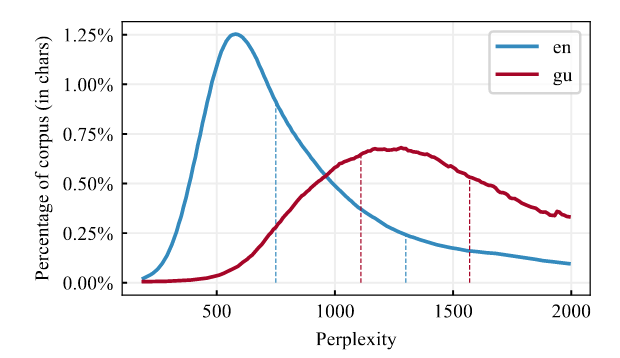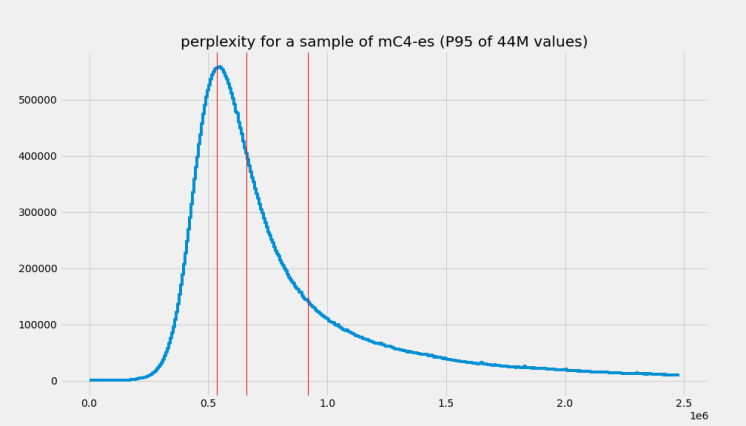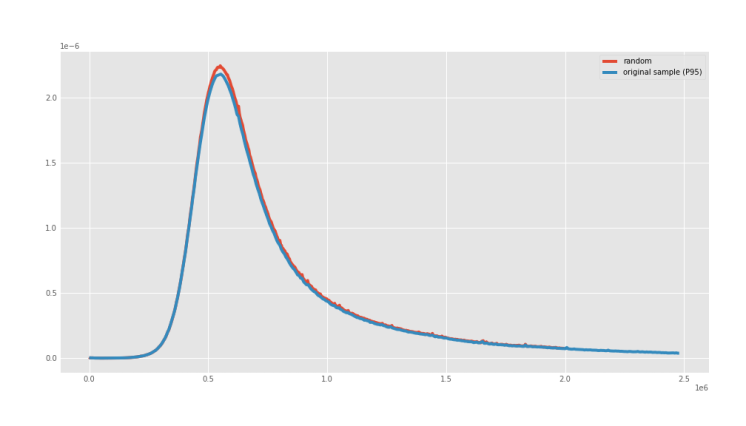language: es
license: CC-BY 4.0
tags:
- spanish
- roberta
pipeline_tag: fill-mask
widget:
- text: Fui a la librería a comprar un <mask>.
- Version 1 (beta): July 15th, 2021
- Version 1: July 19th, 2021
Motivation
According to Wikipedia, Spanish is the second most-spoken language in the world by native speakers (>470 million speakers, only after Chinese, and the fourth including those who speak it as a second language). However, most NLP research is still mainly available in English. Relevant contributions like BERT, XLNet or GPT2 sometimes take years to be available in Spanish and, when they do, it is often via multilanguage versions which are not as performant as the English alternative.
At the time of the event there were no RoBERTa models available in Spanish. Therefore, releasing one such model was the primary goal of our project. During the Flax/JAX Community Event we released a beta version of our model, which was the first in Spanish language. Thereafter, on the last day of the event, the Barcelona Supercomputing Center released their own RoBERTa model. The precise timing suggests our work precipitated this publication, and such increase in competition is a desired outcome of our project. We are grateful for their efforts to include BERTIN in their paper, as discussed further below, and recognize the value of their own contribution, which we also acknowledge in our experiments.
Models in Spanish are hard to come by and, when they do, they are often trained on proprietary datasets and with massive resources. In practice, this means that many relevant algorithms and techniques remain exclusive to large technological corporations. This motivates the second goal of our project, which is to bring training of large models like RoBERTa one step closer to smaller groups. We want to explore technieque that make training this architectures easier and faster, thus contributing to the democratization of Deep Learning.
BERTIN
BERTIN is a series of BERT-based models for Spanish. The current model hub points to the best of all RoBERTa-base models trained from scratch on the Spanish portion of mC4 using Flax. All code and scripts are included.
This is part of the Flax/Jax Community Week, organized by HuggingFace and TPU usage sponsored by Google Cloud.
The aim of this project was to pre-train a RoBERTa-base model from scratch during the Flax/JAX Community Event, in which Google Cloud provided free TPUv3-8 to do the training using Huggingface's Flax implementations of their library.
Spanish mC4
mC4 is a multilingual variant of the C4, the Colossal, Cleaned version of Common Crawl's web crawl corpus. While C4 was used to train the T5 text-to-text Transformer models, mC4 comprises natural text in 101 languages drawn from the public Common Crawl web-scrape and was used to train mT5, the multilingual version of T5.
The Spanish portion of mC4 (mc4-es) contains about 416 million samples and 235 billion words in approximately 1TB of uncompressed data.
$ zcat c4/multilingual/c4-es*.tfrecord*.json.gz | wc -l
416057992
$ zcat c4/multilingual/c4-es*.tfrecord-*.json.gz | jq -r '.text | split(" ") | length' | paste -s -d+ - | bc
235303687795
Perplexity sampling
The large amount of text in mC4-es makes training a language model within the time constraints of the Flax/JAX Community Event by HuggingFace problematic. This motivated the exploration of sampling methods, with the goal of creating a subset of the dataset that allows well-performing training with roughly one eighth of the data (~50M samples) and in approximately half the training steps.
In order to efficiently build this subset of data, we decided to leverage a technique we call perplexity sampling and whose origin can be traced to the construction of CCNet (Wenzek et al., 2020) and their work extracting high quality monolingual datasets from web-crawl data. In their work, they suggest the possibility of applying fast language-models trained on high-quality data such as Wikipedia to filter out texts that deviate too much from correct expressions of a language (see Figure 1). They also released Kneser-Ney models for 100 languages (Spanish included) as implemented in the KenLM library (Heafield, 2011) and trained on their respective Wikipedias.
In this work, we tested the hypothesis that perplexity sampling might help reduce training-data size and training times, while keeping the performance of the final model.
Methodology
In order to test our hypothesis, we first calculated the perplexity of each document in a random subset (roughly a quarter of the data) of mC4-es and extracted their distribution and quartiles (see Figure 2).
With the extracted perplexity percentiles, we created two functions to oversample the central quartiles with the idea of biasing against samples that are either too small (short, repetitive texts) or too long (potentially poor quality) (see Figure 3).
The first function is a Stepwise that simply oversamples the central quartiles using quartile boundaries and a factor for the desired sampling frequency for each quartile, obviously given larger frequencies for middle quartiles (oversampling Q2, Q3, subsampling Q1, Q4).
The second function weighted the perplexity distribution by a Gaussian-like
function, to smooth out the sharp boundaries of the Stepwise function and
give a better approximation to the desired underlying distribution (see Figure 4).
We adjusted the factor parameter of the Stepwise function, and the factor and width parameter of the Gaussian function to roughly be able to sample 50M samples from the 416M in mc4-es (see Figure 4). For comparison, we also sampled randomly mC4-es up to 50M samples as well. In terms of sizes, we went down from 1TB of data to ~200GB.
Figure 5 shows the actual perplexity distributions of the generated 50M subsets for
each of the executed subsampling procedures. All subsets can be easily accessed for reproducibility purposes using the bertin-project/mc4-es-sampled dataset. Since the validation set was too small to extract a 10% (5M) of the samples using perplexity-sampling with the same factor and width, in our experiments we decided to sample from the training sets. In the bertin-project/mc4-es-sampled dataset, the validation set pulls the samples from the original mc4.
from datasets import load_dataset
for config in ("random", "stepwise", "gaussian"):
mc4es = load_dataset(
"bertin-project/mc4-es-sampled",
config,
split="train",
streaming=True
).shuffle(buffer_size=1000)
for sample in mc4es:
print(config, sample)
break
Random sampling displayed the same perplexity distribution of the underlying true distribution, as can be seen in Figure 6.
Training details
We then used the same setup as Liu et al. (2019) but trained only for half the steps (250k) on a sequence length of 128. In particular, Gaussian trained for the 250k steps, while Random was stopped at 230k and Stepwise at 180k (this was a decision based on an analysis of training performance and the computational resources available at the time).
Then, we continued training the most promising model for a few steps (~25k) more on sequence length 512. We tried two strategies for this, since it is not easy to find clear details about this change in the literature. It turns out this decision had a big impact in the final performance.
For Random sampling we trained with seq len 512 during the last 20 steps of the 250 training steps, keeping the optimizer state intact. Results for this are underwhelming, as seen in Figure 7:
For Gaussian sampling we started a new optimizer after 230 steps with 128 seq len, using a short warmup interval. Results are much better using this procedure. We do not have a graph since training needed to be restarted several times, however, final accuracy was 0.6873 compared to 0.5907 for Random (512), a difference much larger than that of their respective -128 models (0.6520 for Random, 0.6608 for Gaussian).
Results
Our first test, tagged beta in this repository, refers to an initial experiment using Stepwise on 128 sequence length and trained for 210k steps. Two nearly identical versions of this model can be found, one at bertin-roberta-base-spanish and the other at flax-community/bertin-roberta-large-spanish (do note this is not our best model!). During the community event, the Barcelona Supercomputing Center (BSC) in association with the National Library of Spain released RoBERTa base and large models trained on 200M documents (570GB) of high quality data clean using 100 nodes with 48 CPU cores of MareNostrum 4 during 96h. At the end of the process they were left with 2TB of clean data at the document level that were further cleaned up to the final 570GB. This is an interesting contrast to our own resources (3xTPUv3-8 for 10 days to do cleaning, sampling, taining, and evaluation) and makes for a valuable reference. The BSC team evaluated our early release of the model beta and the results can be seen in Table 1.
Our final models were trained on a different number of steps and sequence lengths and achieve different—higher—masked-word prediction accuracies. Despite these limitations it is interesting to see the results they obtained using the early version of our model. Note that some of the datasets used for evaluation by BSC are not freely available, therefore it is not possible to verify the figures.
| Dataset | Metric | RoBERTa-b | RoBERTa-l | BETO | mBERT | BERTIN |
|---|---|---|---|---|---|---|
| UD-POS | F1 | 0.9907 | 0.9901 | 0.9900 | 0.9886 | 0.9904 |
| Conll-NER | F1 | 0.8851 | 0.8772 | 0.8759 | 0.8691 | 0.8627 |
| Capitel-POS | F1 | 0.9846 | 0.9851 | 0.9836 | 0.9839 | 0.9826 |
| Capitel-NER | F1 | 0.8959 | 0.8998 | 0.8771 | 0.8810 | 0.8741 |
| STS | Combined | 0.8423 | 0.8420 | 0.8216 | 0.8249 | 0.7822 |
| MLDoc | Accuracy | 0.9595 | 0.9600 | 0.9650 | 0.9560 | 0.9673 |
| PAWS-X | F1 | 0.9035 | 0.9000 | 0.8915 | 0.9020 | 0.8820 |
| XNLI | Accuracy | 0.8016 | WiP | 0.8130 | 0.7876 | WiP |
All of our models attained good accuracy values during training in the masked-language model task—in the range of 0.65—as can be seen in Table 2:
| Model | Accuracy |
|---|---|
| bertin-project/bertin-roberta-base-spanish | 0.6547 |
| bertin-project/bertin-base-random | 0.6520 |
| bertin-project/bertin-base-stepwise | 0.6487 |
| bertin-project/bertin-base-gaussian | 0.6608 |
| bertin-project/bertin-base-random-exp-512seqlen | 0.5907 |
| bertin-project/bertin-base-gaussian-exp-512seqlen | 0.6873 |
Downstream Tasks
We are currently in the process of applying our language models to downstream tasks. For simplicity, we will abbreviate the different models as follows:
- BERT-m: bert-base-multilingual-cased
- BERT-wwm: dccuchile/bert-base-spanish-wwm-cased
- BSC-BNE: BSC-TeMU/roberta-base-bne
- Beta: bertin-project/bertin-roberta-base-spanish
- Random: bertin-project/bertin-base-random
- Stepwise: bertin-project/bertin-base-stepwise
- Gaussian: bertin-project/bertin-base-gaussian
- Random-512: bertin-project/bertin-base-random-exp-512seqlen
- Gaussian-512: bertin-project/bertin-base-gaussian-exp-512seqlen
| Model | POS (F1/Acc) | NER (F1/Acc) | PAWS-X (Acc) | XNLI-256 (Acc) | XNLI-512 (Acc) |
|---|---|---|---|---|---|
| BERT-m | 0.9629 / 0.9687 | 0.8539 / 0.9779 | 0.5765 | 0.7852 | |
| BERT-wwm | 0.9642 / 0.9700 | 0.8579 / 0.9783 | 0.8720 | 0.8186 | |
| BSC-BNE | 0.9659 / 0.9707 | 0.8700 / 0.9807 | 0.5765 | 0.8178 | |
| Beta | 0.9638 / 0.9690 | 0.8725 / 0.9812 | 0.5765 | 0.3333 | |
| Random | 0.9656 / 0.9704 | 0.8704 / 0.9807 | 0.8800 | 0.7745 | 0.7795 |
| Stepwise | 0.9656 / 0.9707 | 0.8705 / 0.9809 | 0.8825 | 0.7820 | 0.7799 |
| Gaussian | 0.9662 / 0.9709 | 0.8792 / 0.9816 | 0.8875 | 0.7942 | 0.7843 |
| Random-512 | 0.9660 / 0.9707 | 0.8616 / 0.9803 | 0.6735 | 0.7723 | 0.7799 |
| Gaussian-512 | 0.9662 / 0.9714 | 0.8764 / 0.9819 | 0.8965 | 0.7878 | 0.7843 |
In addition to the tasks above, we also trained the beta model on the SQUAD dataset, achieving exact match 50.96 and F1 68.74 (sequence length 128). A full evaluation of this task is still pending.
To note: not intense tuning, epochs, etc. Still, good?? PAWS-X: weird (large differences and repeated base value). Repeated and same, with minor differences.Sometimes too short training? XNLI-512, runtime ~19h per model.
Bias and ethics
While a rigorous analysis of our models and datasets for bias was out of the scope of our project (given the very tight schedule and our lack of experience on JAX/FLAX), this issue has still played an important role in our motivation. Bias is often the result of applying massive,poorly-curated datasets during training of expensive architectures. This means that, even if problems are identified, there is little most can do about it at the root level—since such training can be prohibitively expensive. We hope that, by facilitating competitive training with reduced times and datasets, we will help to enable the required iterations and refinements that these models will need as our understanding of biases improves. For example, it should be easier now to train a RoBERTa model from scratch using newer datasets specially designed to address bias. This is surely an exciting prospect, and we hope that this work will contribute in this challenge.
Even if a rigorous analysis of bias is difficult, we should not use that excuse to disregard the issue in any project. Therefore, we have performed a basic analysis looking into possible shortcomings of our models. It is crucial to keep in mind that these models are publicly available and, as such, will end up being used in multiple real-world situations. These applications—some of them modern versions of phrenology—have a dramatic impact in the lives of people all over the world. We know Deep Learning models are in use today as law assistants, in law enforcement, as exam-proctoring tools (also this), for recruitment (also this) and even to target minorities. Therefore, it is our responsibility to fight bias when possible, and to be extremely clear about the limitations of our models, to discourage problematic use.
Analysis
The performance of our models has been, in general, very good. Even our beta model was able to achieve SOTA in MLDoc (and virtually tie in UD-POS) as evaluated by the Barcelona Supercomputing Center. In the main masked-language task our models reach values between 0.65 and 0.69, which foretells good results for downstream tasks.
Our analysis of downstream tasks is not yet complete. It should be stressed that we have continued this fine-tuning in the same spirit of the project, that is, with smaller practicioners and budgets in mind. Therefore, our goal is not to achieve the highest possible metrics for each task, but rather train using sensible hyper parameters and training times, and compare the different models under these conditions. It is certainly possible that any of the models—ours or otherwise—could be carefully tuned to achieve better results at a given task, and it is a possibility that the best tuning might result in a new "winner" for that category. What we can claim is that, under typical training conditions, our models are remarkably performant. In particular, Gaussian-512 is clearly superior, taking the lead in three of the four tasks analysed.
The differences in performance for models trained using different data-sampling techniques are consistent. Gaussian-sampling is always first, while Stepwise is only marginally better than Random. This proves that the sampling technique is, indeed, relevant.
As already mentiond in the Training details section, the methodology used to extend sequence length during training is critical. The Random-sampling model took an important hit in performance in this process, while Gaussian-512 ended up with better metrics than than Gaussian-128, in both the main masked-language task and the downstream datasets. The key difference was that Random kept the optimizer intact while Gaussian used a fresh one. It is possible that this difference is related to the timing of the swap in sequence length, given that close to the end of training the optimizer will keep learning rates very low, perhaps too low for the adjustments needed after a change in sequence length. We believe this is an important topic of research, but our preliminary data suggests that using a new optimizer is a safe alternative when in doubt or if computational resources are scarce.
Conclusions
With roughly 10 days worth of access to 3xTPUv3-8, we have achieved remarkable results surpassing previous state of the art in a few tasks, and even improving document classification on models trained in massive supercomputers with very large—private—and highly-curated datasets.
The very big size of the datasets available looked enticing while formulating the project, however, it soon proved to be an important challenge given time constraints. This lead to a debate within the team and ended up reshaping our project and goals, now focusing on analysing this problem and how we could improve this situation for smaller teams like ours in the future. The subsampling techniques analysed in this report have shown great promise in this regard, and we hope to see other groups use them and improve them in the future.
At a personal leve, we agree that the experience has been incredible, and we feel this kind of events provide an amazing opportunity for small teams on low or non-existent budgets to learn how the big players in the field pre-train their models, certainly stirring the research community. The trade-off between learning and experimenting, and being beta-testers of libraries (Flax/JAX) and infrastructure (TPU VMs) is a marginal cost to pay compared to the benefits such access has to offer.
Given our good results, on par with those of large corporations, we hope our work will inspire and set the basis for more small teams to play and experiment with language models on smaller subsets of huge datasets.
Team members
- Javier de la Rosa (versae)
- Eduardo González (edugp)
- Paulo Villegas (paulo)
- Pablo González de Prado (Pablogps)
- Manu Romero (mrm8488)
- María Grandury (mariagrandury)
Useful links
- Community Week timeline
- Community Week README
- Community Week thread
- Community Week channel
- Masked Language Modelling example scripts
- Model Repository
References
CCNet: Extracting High Quality Monolingual Datasets from Web Crawl Data, Guillaume Wenzek, Marie-Anne Lachaux, Alexis Conneau, Vishrav Chaudhary, Francisco Guzmán, Armand Joulin, Edouard Grave, Proceedings of the 12th Language Resources and Evaluation Conference (LREC), p. 4003-4012, May 2020.
Heafield, K. (2011). KenLM: faster and smaller language model queries. In Proceedings of the EMNLP2011 Sixth Workshop on Statistical Machine Translation.








